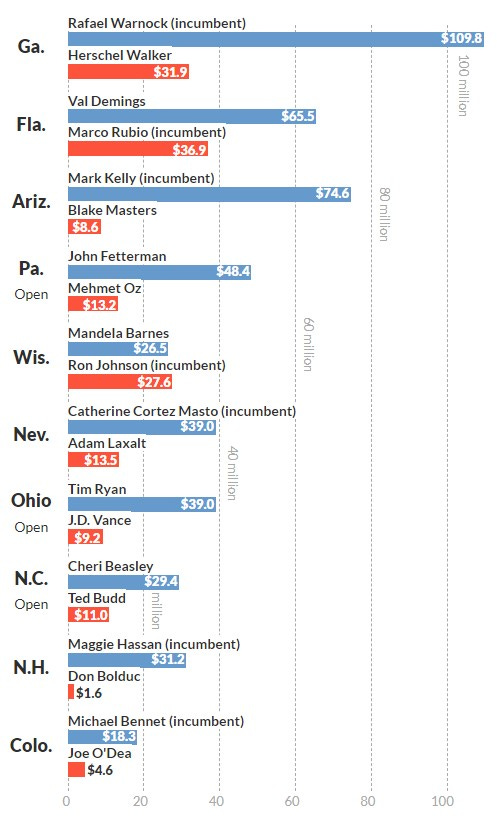Part 1: The GOP's Silver Linings Playbook
In many ways, it was a classic midterm election: All politics are, in fact, local. And there are silver linings for the GOP. Part II: What happens now?
It’s been nearly two weeks since the status quo elections of 2022 that disappointed Republicans but gave Democrats little to cheer for other than a sigh of relief.
It is huge that Democrats kept control of the Senate. They will continue to stack the judiciary with hard-left judges for two more years. Pray for the continued good health of Clarence Thomas and divine protection against assassination attempts on all conservative Supreme Court justices.
It is equally huge that Republicans won control of the US House of Representatives and, with it, the gavel over several key committees: Judiciary, Homeland Security, and Appropriations, among others.
As a result, expect very little from Congress over the next two years, even though bipartisan agreement is possible on bills such as banning stock trading by Members of Congress and the Communist Chinese data-collecting app Tik Tok.
There are two questions we hope to answer. While votes are embarrassingly still being counted and elections certified, what are the final takeaways from a GOP perspective on the 2022 elections? And with a divided Congress with each chamber majority enjoying razor-thin majorities, what happens now?
A favorite award-winning movie from a decade ago, filmed and based not far from where I lived, was “Silver Linings Playbook.” It starred Philadelphia native Bradley Cooper and Jennifer Lawrence, who won an Academy Award for her performance. We’ll let Wikipedia describe the plot.
After eight months' treatment in a mental health facility for bipolar disorder, Patrizio "Pat" Solitano Jr. is released into the care of his father, Patrizio Sr., and mother, Dolores, at his childhood home in Upper Darby, Pennsylvania. His primary focus is to reconcile with his ex-wife, Nikki. She has moved away and obtained a restraining order against him after Pat found her in the shower with another man and badly beat him.
During his time in the clinic, Pat befriended Danny McDaniels, an easygoing man who is embroiled in a legal dispute with the clinic over whether or not he is eligible to leave. Pat's therapist, Cliff Patel, tries to convince him to keep taking his medication, as a repeat of his violent outbursts might send him back to the clinic. Pat tells him that he has a new outlook on life: He attempts to see the good, or silver linings, in all that he experiences. Pat employs the phrase "Excelsior," or "ever upward," as his new optimistic mantra. Meanwhile, Pat experiences a series of anxiety attacks, including a violent reaction to Ernest Hemingway's A Farewell to Arms, which he throws into the yard, destroying his bedroom window in the process.
I do not mean to demean, diminish, or politicize bipolar disorder. But Republicans are clearly in the throes of their political version of that with their alternating intense and exhausting love or hate for its putative leader since 2016, Donald Trump.
He played an outsized role in the 2022 elections. Trump recruited, inspired, and endorsed - or attacked - candidates based mainly on whether they subscribed to his belief that the 2020 elections were “stolen.” He doled out some 200-plus endorsements, including for candidates who didn’t seek them and didn’t face serious challenges. But in marquee races, candidates who loved him back didn’t far very well. I wrote about that last week. Most lost (Arizona, New Hampshire, etc.), and those who won (or now face a runoff election) trailed other Republicans on the ballot (Ohio, Georgia, etc.). But despite eroding 2024 presidential primary poll numbers, Trump remains the 800-pound gorilla in the GOP with a large and loyal fan base.
Trump wasted no time being the first to announce his candidacy for the 2024 GOP nomination. He won’t be the last.
While more data continues to trickle in, let’s summarize the primary factors behind the GOP’s disappointing performance, which badly trailed the usual midterm election results for the party “out of power.”
It was a classic midterm election
True, the GOP underperformed nationally for a typical midterm election. But as former US House Speaker Tip O’Neill said famously, “All politics is local.” Republican “red waves” occurred in some states, especially Florida, which handily voted to reelect Democratic President Barack Obama ten years ago. Incumbent Governor Ron DeSantis and US Senator Marco Rubio not only won by double digits, but the GOP gained four US House seats and even swept several contentious school board elections. Florida is now a red state.
The same is true in Ohio, where incumbent Governor Mike DeWine romped to a 25-point win. The GOP also won three partisan State Supreme Court elections by double digits and, by a narrower margin, kept its open US Senate seat in GOP hands with author JD Vance.
But the opposite was true in Michigan, where voters reelected hard-left lockdown Governor Gretchen Whitmer by double digits over her badly-underfunded opponent, the Trump-endorsed Tudor Dixon. Whitmer also won Democratic control over both the state House and Senate.
Reminiscent of a scene from the bawdy classic, “Animal House,” Michigan has a new motto: “Thank you, ma’am, may I have another?” I guess losing to Ohio State in college football eight years in a row has conditioned Michiganders to embrace humiliation.
Other states were a mixed bag, including New York. Republican US Rep. Lee Zeldin fell short while outperforming the last four GOP gubernatorial nominees. But Republicans gained four congressional seats and kept one many thought would be lost. In New Hampshire, voters handily reelected GOP Gov. Chris Sununu but soundly rejected Trumpian candidates for US Senate and two US House seats. Arizona narrowly rejected Trump-endorsed candidates for Governor and US Senate, but the GOP converted two US House seats.
Local factors plus an adverse reaction to Trump-endorsed candidates drove a lot of ticket-splitting in these states. In addition, fear of Trump may have kept stronger candidates for running for US Senate seats in Arizona (retiring Gov. Doug Ducey) and New Hampshire (Sununu). GOP governors did very well, from Oklahoma to Florida. Democrats converted open seats in Maryland and Massachusetts but lost Nevada. Surprisingly, Kansans narrowly reelected their Democratic governor.
It was a night for incumbents across the board. Few challengers won. Very few. Democrats generally appear to have done better in “open seats” (no incumbent).
The GOP lost self-identified Independents
Republican strategist, pollster, and analyst David Winston outlined my key takeaway from the 2022 election (emphasis added):
. . .wave elections tend to show at least double-digit gains among independents, with examples being 2010 in which independents voted for Republicans by 19, and in 2018 with independents voting for Democrats by 12. At this point, exit polls (not final) how that the independent vote margin stands at +2D. Even with the party ID advantage for Republicans, this was not enough to make up for this margin among independents and shows Republicans have work to do to improve among independents. Preliminary exit polls also show independents comprised 31% of the electorate - up from 27% since 2020.
The takeaway is that while independents were unhappy with the Biden record or agenda, they didn’t like what the GOP was pitching. Republicans seemed more intent on running a “base” election with little appeal to Independents on issues that motivated them. The House GOP’s carefully-crafted but diffuse “Commitment to America” wasn’t used by its candidates. And . . .
Candidates running as “pro-Trump” lost or underperformed
Trump’s late-election machinations led them to reject candidates who ran as his supporters. As previously reported, one Florida survey showed 43 percent of voters “much less likely” to support candidates seen as Trump supporters. While it is unfair to blame Trump entirely for the GOP’s underperformance, his influence over the electorate turned off a lot of voters.
Bush 43 political advisor Karl Rove wrote this in the Wall Street Journal: “Many of these remarkably weak candidates came courtesy of Donald Trump, who didn’t vet his endorsements. … Mr. Trump turned what should have been a referendum on Mr. Biden’s terrible record into a choice between himself and the current president. As in 2020, lots of voters chose Mr. Biden.”
Democrats enjoyed a significant money advantage
The final numbers won’t be in until the year-end Federal Election Commission disclosure reports are filed early next year. But there’s no doubt that Democrats mostly enjoyed a huge financial advantage in competitive elections, especially in small-donor contributions. US Senator-elect JD Vance (R-OH):
Money is how candidates fund the all-important advertising that reaches swing voters, and it’s how candidates fund turnout operations. And in every marquee national race, Republicans got crushed financially.
The reason is ActBlue. ActBlue is the Democrats’ national fundraising platform, where 21 million individual donors shovel small donations into every marquee national race. ActBlue is why my opponent ran nonstop ads about how much he “agreed with Trump” during the summer. It is why John Fetterman was able to raise $75 million for his election.
Republican small dollar fundraising efforts are paltry by comparison, and Republican fundraising efforts suffer from high consultant and “list building” fees—where Republicans pay a lot to acquire small-dollar donors. This is why incumbents have such massive advantages: much of the small-dollar fundraising my own campaign did went to fundraising and list-building expenses. If and when I run for reelection, almost all of it will go directly to my campaign. Democrats don’t have this problem. They raise more money from more donors, with lower overhead.

Add to all this the money raised and spent in the campaign’s final weeks and over $1 billion invested by outside groups for independent expenditures. Federal and state political spending will approach $17 billion in 2022. That’s obscene.
Democrats have mastered voting by mail
While Republicans won across the board in Florida, they appear to have lost the vote-by-mail sweepstakes, even there. CBS News Miami:
There have been more than 4.2 million vote-by-mail ballots returned in Florida.
Statewide, voters had cast 4,219,025 mail-in ballots, with 1,947,545 by Democrats and 1,316,109 by Republicans.
Another 901,806 ballots had been cast by unaffiliated voters, while third-party voters had cast 53,565.
Overall, there are more than 1.7 million mail ballots requested but not yet returned. Of those, 734-thousand are held by Democrats and more than 554-thousand are with Republicans.
In fairness, Republicans did much better on in-person early voting. But in Pennsylvania, where in-person early voting is not allowed, it’s a similar refrain. Salena Zito:
The first thing Allegheny County (Pennsylvania) Republican Chairman Sam DeMarco saw on election night after the polls closed was the more than 100,000 votes from his home county that dropped for Democrat John Fetterman through mail-in ballots. Although he wasn’t sure just yet that meant the race was lost, he also knew Republicans needed to fix something in the party’s way of doing things going forward.
“Those initial large dump of voters were mail-in ballots from Democrats,” he said of the advance voting that began in 2020 during the pandemic. Democrats embraced it with gusto, but Republicans shied away.
“The biggest takeaway from Tuesday night is that Republican attitudes in regard to mail-in voting needs to change,” he continued. “Right now, it’s like we’re running a 100-yard race against the Democrats and giving them a 45-yard head start. Both parties have limited resources, but while they work during the 50 days of early voting collecting and banking early votes … we’re just collecting promises to show up on Election Day; it’s not sustainable, and Democrats get better at it every cycle.”
In all, some 2.6 million votes were cast by mail in Pennsylvania. Some 4.2 million voted on election day. In 2020, while Trump carried the election day voting by over 60 percent, Joe Biden won 77 percent of votes by mail. Turnout in the 2022 midterm elections was an incredibly high 76 percent in the Keystone State.
And while the GOP mostly did well in North Carolina, they also fell behind in mail ballots.

Democrats have mastered voting by mail. They and their allied organizations send absentee ballot applications to voters. They track their return. They hound people until they return them. They offer to “voting assistance.” And only then do they focus on getting “ballots” from Democrats on election day. Democrats run active campaigns to encourage voting by mail (or drop box where allowed). And in many states, such as Pennsylvania and North Carolina, they can drop their ballots in the mail on election day (so long as they are postmarked by election day).
Republicans need a two-part strategy. First, tighten state laws on verifying, distributing, receiving, and counting mail ballots. Second, they have to get better at the game. After a long day at work on election day, some GOP voters head home instead of waiting in line for hours at the polls. Especially if they believe their vote might not be needed or make any difference. Voting by mail, while cumbersome for local election systems, prone to errors and fraud, and far less secure than voting in person, is easier for many people. An increasing number of states now pay for postage. Never mind the eight states that conduct their elections entirely by mail.
We need a serious debate about how voting by mail destroys confidence in our elections.

This also affects the way campaigns spend money. Since early voting can begin as much as 45 days (see: Virginia) before “Election Day,” saving your advertising spend for the last weeks no longer makes sense. This puts pressure on campaigns to raise and spend money earlier than customary. Again, the advantage to Democrats.
Republicans “frightened” independent voters or failed to “close the sale”
Newly-reelected Senate GOP Leader Mitch McConnell, as reported by the American Wire:
“Every one of our candidates knew what they were for, expressed it quite clearly. It’s pretty obvious and all of you have been writing about it,” the Kentucky Republican replied. “What happened? We underperformed among independents and moderates because their impression of many of the people in our party in leadership roles is that they’re engulfed in chaos, negativity, excessive attacks, and it frightened independent and moderate Republican voters.”
“And we saw that, which is why you all recall, I never predicted a red wave,” he continued. “We never saw that in any of our polling in the states that we were counting on to win. There was no wave. We had national issue set that was favorable, but as a result of our own — the perception many of them had that we were not dealing with issues in a responsible way and that we were spending too much time on negativity and attacks and chaos, they were frightened, and so they pulled back.”
US Sen. Rick Scott (R-FL), chair of the National Republican Senatorial Committee (NRSC), the Senate GOP’s official campaign arm, broadly agreed, as he told Fox News host Sean Hannity:
"Here’s what happened to us. Election Day, our voters didn’t show up. We didn’t get enough voters. It’s a complete disappointment," Scott said. "We’ve got to reflect now. What didn’t happen? I think we didn’t have enough of a positive message."
"We said everything about how bad the Biden agenda was. It’s bad, the Democrats are radical, but we have to have a plan of what we stand for."
Scott unsuccessfully challenged McConnell in the leadership election this week to replace him and faces reelection in Florida in 2024. He was ineligible to continue as the GOP’s campaign chair for the next election when Democrats will defend 21 of 34 seats. US Sen. Steve Daines (R-MT) was elected by the Senate GOP conference this week to succeed Scott.
The data here is scant and trickling in. Party and media professionals will analyze GOP versus Democratic messaging over the next several months. But there is broad agreement that the GOP offered independents no compelling reason to prefer their policy agenda over the Democrats. At least what they heard of one.
But despite all this, there are silver linings.
Republicans made broad gains among voter groups
While exit polling is notoriously finicky, there is one big silver lining for Republicans. They broadly performed better among several voter demographics than in the 2018 midterm elections. Not a perfect comparison, admittedly, since that was Trump’s midterm election in a different environment. But still useful.

DeSantis and Rubio won heavily Hispanic Miami-Dade and heavily Puerto Rican Osceola Counties, historic firsts. Even traditionally-Democratic Palm Beach County.
But while under-30 voters favored Democrats in 2022, their proportion of the turnout (13%, compared to 12% in 2018) was broadly consistent with past elections, and Republicans narrowed the gap from 2018. And Republicans upped their share of the rural vote while narrowly winning among suburbanites and cutting their losses with urban voters. And let’s acknowledge that some of these trends began with Donald Trump.

While the GOP has much work ahead, they can find silver linings in many places.
Part II: What happens next?




